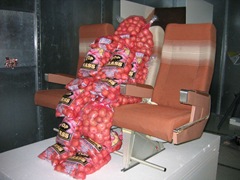A number of news agencies including the BBC and the AP have picked up on the story about how Boeing tested the wi-fi in its aircraft by substituting sacks of potatoes for passengers. Apparently, Boeing needed to fill up an entire aircraft with passengers because wireless signals will fluctuate randomly in the enclosed space of an aircraft cabin as passengers and crew move about. That means some seats will have a spotty or inconsistent connection plus engineers needed to ensure that the wi-fi did not interfere with any of the aircraft’s navigational systems.
 However, human passengers could not be asked to sit still for days while the company’s engineers collected data. Luckily, potatoes interact with electronic signals in a similar way to humans and Boeing ended up filling the seats of a decommissioned aircraft with 20,000 lbs (9,000kg) of potatoes in sacks.
However, human passengers could not be asked to sit still for days while the company’s engineers collected data. Luckily, potatoes interact with electronic signals in a similar way to humans and Boeing ended up filling the seats of a decommissioned aircraft with 20,000 lbs (9,000kg) of potatoes in sacks.
Boeing came up with the idea to use potatoes after a member of the research team came across a Journal of Food Science article that described research where 15 different vegetables and fruits were evaluated for the way they transmit electric force without conduction. It turns out that potatoes have a water content and chemistry that absorbs and reflects radio wave signals in much the same way as the human body does.
Add some complex statistical analysis and Boeing was able to come up with a proprietary system for fine tuning Internet signals to ensure their strength and reliability wherever a laptop is used aboard an aircraft. Boeing also needed to check what any peak signals would be – especially if 300 passengers decide to surf the Internet all at once.
And if you are wondering what Boeing did with all of those potatoes, a CNN segment about the project noted that they were given to a local food bank to help the needy.
Leave a Reply